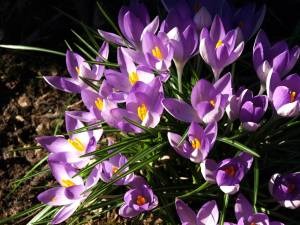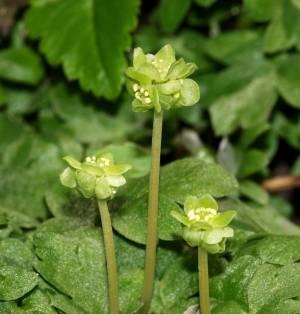Dr Phil Smith’s Wildlife Notes
March 2010
This unusually cold winter continued its grip well into March, with the result that many spring flowers appeared about a month later than usual. Thus, Snowdrops (Galanthus nivalis) were not at their best until the first week, a particularly fine display being at Cabin Hill wood. Presumably these were introduced by the hermit who used to live there in a little brick cottage, now long demolished. Nearby Range Lane, Formby, had some gloriously vivid clumps of the Early Crocus (Crocus tommasinianus), while the much rarer Hybrid Crocus (Crocus vernus x tommasinianus) appeared at Kenilworth Road dunes, Ainsdale and Hesketh Road, Marshside. One plant of Golden Crocus (C. chrysanthus) at Kenilworth Road seems to be new record for the dunes. These, and the many other spring bulbs are all garden-escapes, of course, but no less welcome in providing a splash of colour at this time of year.

Another interesting plant is Moschatel, sometimes known as Townhall Clock (Adoxa moschatellina), which I was surprised to find in some abundance in a woodland fragment off Ashdale Close, Formby. The name refers to the strange arrangement of the yellowish-green flower-head with four flowers on opposite faces and one on top. I have never seen this species before in the district.

Attending a two-day conference on sand-dune hydrology in Southport reminded me just how much we rely on winter rainfall to recharge the dune aquifer and top up water-levels in our dune slacks, these being one of our most important wildlife habitats. Following on from a dry winter and a three-week total drought in February/March, the rains late in the month were therefore particularly welcome. I visited the wetlands of Cabin Hill on 27th, counting at least 200 fresh batches of Common Frog-spawn. Common Toads were also active, with several balls of struggling males around long-suffering females trying to get on with laying their long spawn strings. Surprisingly, I counted 75 Common Toad corpses in a relatively small area, most having lost their back legs. Such predation is unusual, as this species is normally well protected by skin poisons.
On a recent trip to Tesco, I heard an unfamiliar bird-call. It was a House Sparrow, once abundant everywhere, now sadly declining in most places, seemingly due to the lack of spilt grain from agriculture and fewer insects to feed its young. The RSPB has targeted it for conservation and 20 specially designed nest-boxes have been set up at Marshside, where an exceptional flock of 109 House Sparrows was recently reported.
While a few winter birds, including one or two Snow Buntings on Ainsdale beach and two Bean Geese at Plex Moss, remained during March, the usual summer visitors began to arrive. One of the earliest is the Wheatear, the first I heard about being at Marshside on 17th, not much later than normal. Sand Martins appeared the following day and the first Swallows on about 23rd. I was pleased to find three Sandwich Terns on Birkdale beach on 22nd. More unusual were a Green Woodpecker seen by Rachael Parks at Greenloons Drive, Formby, on 18th, two Black Redstarts at Seaforth Nature Reserve on 23rd and 25th, a Long-billed Dowitcher at Banks on 7th-8th and an American Wigeon at Martin Mere from 9th. The last named site had a record number of 112 Avocets on 25th, an extraordinary total for a bird which was a rarity in the district less than a decade ago.
